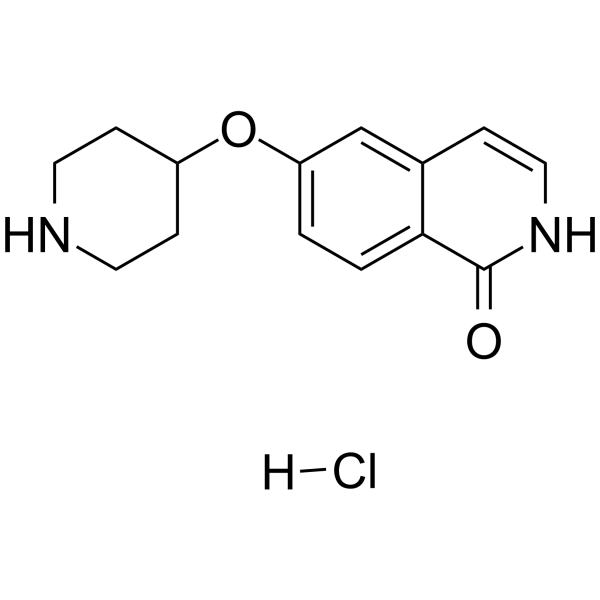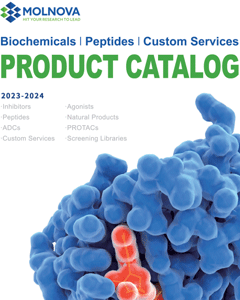
SAR407899 hydrochloride
CAS No. 923262-96-8
SAR407899 hydrochloride( —— )
Catalog No. M27702 CAS No. 923262-96-8
SAR407899 hydrochloride is a selective, potent and ATP-competitive ROCK inhibitor, with an IC50 of 135 nM for ROCK-2, and Kis of 36 nM and 41 nM for human and rat ROCK-2, respectively.
Purity : >98% (HPLC)
 COA
COA
 Datasheet
Datasheet
 HNMR
HNMR
 HPLC
HPLC
 MSDS
MSDS
 Handing Instructions
Handing Instructions
| Size | Price / USD | Stock | Quantity |
| 5MG | 42 | Get Quote |


|
| 10MG | 65 | Get Quote |


|
| 25MG | 115 | Get Quote |


|
| 50MG | 200 | Get Quote |


|
| 100MG | 320 | Get Quote |


|
| 500MG | 758 | Get Quote |


|
| 1G | Get Quote | Get Quote |


|
Biological Information
-
Product NameSAR407899 hydrochloride
-
NoteResearch use only, not for human use.
-
Brief DescriptionSAR407899 hydrochloride is a selective, potent and ATP-competitive ROCK inhibitor, with an IC50 of 135 nM for ROCK-2, and Kis of 36 nM and 41 nM for human and rat ROCK-2, respectively.
-
DescriptionSAR407899 hydrochloride is a selective, potent and ATP-competitive ROCK inhibitor, with an IC50 of 135 nM for ROCK-2, and Kis of 36 nM and 41 nM for human and rat ROCK-2, respectively.
-
In VitroSAR407899 hydrochloride is a potent and ATP-competitive ROCK inhibitor, with Kis of 36 nM and 41 nM for human and rat ROCK-2, respectively. SAR407899 inhibits ROCK-2 better than ROCK-1, with IC50s of 102±19 nM and 276±26 nM, respectively, in the presence of 40 μM ATP. SAR407899 also less potently inhibits PKC-Δ and MSK-1, with IC50s of 5.4 and 3.1 μM, respectively. SAR407899 (0.1, 0.3, 1.0, and 3.0 μM) specifically inhibits the ROCK-mediated phosphorylation of MYPTT696 in HeLa cells stimulated with PHEN, and shows such effects at 1 μM and 10 μM in primary rat aortic smooth muscle cells. SAR407899 (3 μM) completely blocks thrombin-induced shrinkage of human umbilical vein endothelial cells (HUVECs) and stress fiber formation. SAR407899 concentration-dependently inhibits 5-bromodeoxyuridine incorporation into the cells with an IC50 of 5.0±1.3 μM. SAR407899 also effectively inhibits THP-1 migration with an IC50 of 2.5±1.0 μM. SAR407899 shows a potent vasorelaxant activity in a broad variety of isolated arteries taken from different vascular beds and species, with a range of IC50 values between 122 and 280 nM. SAR407899 dose-dependently relaxes the phenylephrine pre-contracted smooth muscle, with IC50s of 0.07 and 0.05 μM, respectively.
-
In VivoSAR407899 (3 mg/kg, i.v.) inhibits ROCK-mediated phosphorylation of MYPTT696 in thoracic aorta of spontaneously hypertensive rats (SHRs). SAR407899 (0.01-0.30 mg/kg, i.v.) efficiently reduces pressor responses to vasoconstrictor agents in rats. SAR407899 (1, 3, 10, and 30 mg/kg, p.o.) dose dependently lowers blood pressure in hypertensive SHRs. SAR407899 (1-3 mg/kg, i.v. or 3, 10 mg/kg, p.o.) increases the length of the penis in healthy rabbits. SAR407899 (3-10 mg/kg, p.o.) also dose-dependently increases penile length in diabetic rabbits.
-
Synonyms——
-
PathwayCell Cycle/DNA Damage
-
TargetROCK
-
Recptorα1A-adrenergic receptor
-
Research Area——
-
Indication——
Chemical Information
-
CAS Number923262-96-8
-
Formula Weight280.75
-
Molecular FormulaC14H17ClN2O2
-
Purity>98% (HPLC)
-
SolubilityIn Vitro:?H2O : 50 mg/mL (178.09 mM)
-
SMILESCl.O=c1[nH]ccc2cc(OC3CCNCC3)ccc12
-
Chemical Name——
Shipping & Storage Information
-
Storage(-20℃)
-
ShippingWith Ice Pack
-
Stability≥ 2 years
Reference
1.Ford AP, et al. RS-17053 (N-[2-(2-cyclopropylmethoxyphenoxy)ethyl]-5-chloro-alpha, alpha-dimethyl-1H-indole-3-ethanamine hydrochloride), a selective alpha 1A-adrenoceptor antagonist, displays low affinity for functional alpha 1-adrenoceptors in human prostate: implications for adrenoceptor classification. Mol Pharmacol. 1996 Feb;49(2):209-15.
molnova catalog



related products
-
Orexin 2 Receptor Ag...
Orexin 2 Receptor Agonist is an effective (EC50: 23 nM) and OX2R-selective (OX1R/OX2R EC50 ratio: 70) agonist.
-
Y27632
Y-27632 is a selective ROCK1 (p160ROCK) inhibitor with Ki of 140 nM in a cell-free assay.
-
MD 39-AM
Anticytokinin activity was evaluated by 50% of the callus growth on the medium with kinetin but without anti-cytokinin



 Cart
Cart
 sales@molnova.com
sales@molnova.com


